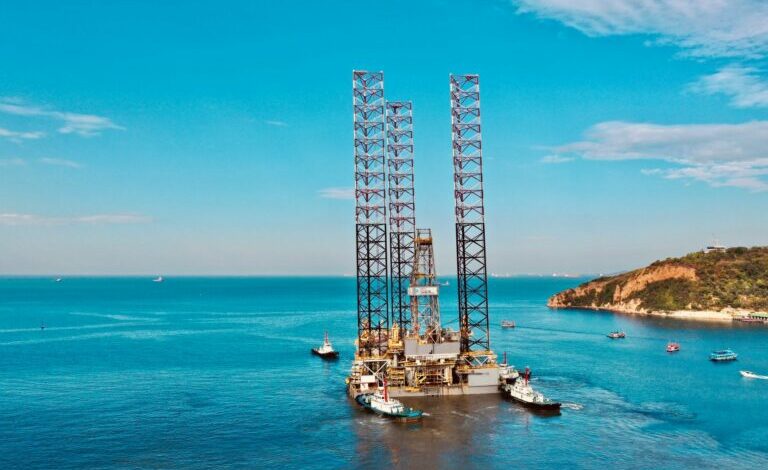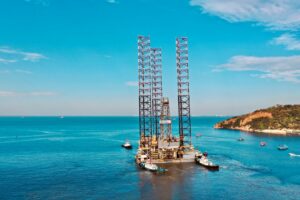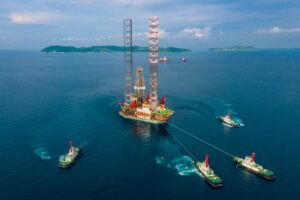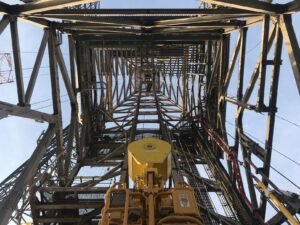Market fragmentation, COVID restrictions keep pressures on offshore drilling companies


Shelf Drilling’s David Mullen: While improving oil prices should lead to a better market, drilling contractors in jackup space still lack leverage for pricing power
By Linda Hsieh, Editor & Publisher
David Mullen is CEO of Shelf Drilling.
Shelf Drilling operates multiple jackups in the Middle East, Asia and Africa. From your perspective, how is the health of the offshore drilling industry?
It is improving. There has been a great run-up in oil prices over the past 12 months, so I believe the market will continue to improve even more in the coming months.
Of course, many challenges remain. First, cost of capital continues to escalate, and you might even say access to capital has become very limited. This hasn’t truly impacted many of the drilling contractors yet because a lot of them went into Chapter 11 and underwent restructuring in an effort to transform their balance sheets, but it’s going to become more of a concern.
Companies are going to need access to new capital, and we are seeing large institutions shy away from fossil fuels in general due to sustainability concerns and the onset of the energy transition. This trend will continue to impact access to capital even while the world is going to continue to need fossil fuels, so I’m not sure that the approach of limiting access to capital will lead to the right outcome. The energy transition is necessary, but it will require a lot more planning and coordination. We are currently experiencing an energy crisis in Europe, with extremely high gas prices. It was brought on by a lack of investment and, more importantly, lack of planning.
Second, we’re still facing cost and logistical complications with the ongoing COVID-19 pandemic. While COVID restrictions have begun to ease up in a lot of our operating regions, like West Africa, India, Southeast Asia, the Mediterranean and the Middle East, we’re still experiencing logistical constraints. I’d like to think the pandemic’s effects are behind us, but that’s wishful thinking. I think it’s going to be around for quite a while longer.
When it comes to rig crews, there remain logistical challenges getting them out to the rigs. In certain geographies, if you have a COVID case, local governments could mandate rather onerous standard operating procedures on what you must do with the entire crew.
Quarantine requirements also impact your personnel. People are tired of having to spend seven days in a hotel before they go to work. It’s put a strain on them psychologically. In some cases, it means people have to have extended time offshore. We’ve been quite fortunate in this regard because most of our rigs are operating in geographies where we almost have full national content. That makes life a lot easier, but it’s still a challenge in terms of cost and logistics.
And then there are supply chain issues that resulted both from COVID and the downturn. All major oilfield equipment suppliers had basically shut down their manufacturing due to COVID disruptions. If you wanted major pieces of equipment such as blowout prevention stacks, top drives or pipe racking systems, you had to wait 12-18 months. Now, if everybody suddenly places an order, you could wait two or three years. We are experiencing increasing lead times for equipment and additional cost.
The third challenge, and perhaps it’s the most important one for the jackup market specifically, is that our industry is extremely fragmented. The floater market is starting to consolidate, and they now enjoy significantly improved pricing dynamics. On the other hand, there remain far too many contractors in the jackup space. There’s an absolute need for consolidation. With the degree of fragmentation we’ve got, there’s no pricing power, and there’s very little capital discipline. Given the level of utilization today, we should see better pricing power, and we should see more financial discipline on investment activities. However, neither of those are the case.

Why is consolidation happening in the floater segment but not the jackup segment?
In the floater space, there are a lot of like-for-like companies. In the jackup space, there are a lot of regional companies. Some are supported by national oil companies or by national content, so it’s more challenging to enact meaningful consolidation.
Also, unlike the floater segment, the jackup segment did not experience a high level of restructuring.
You mentioned there’s been a strong run-up in oil prices, but why do you think we haven’t seen an equal run-up in rig contracts, dayrates and activity levels?
Great question. The primary reason is that large integrated oil companies are looking to diversify out of oil and gas and invest in emerging technologies, such as hydrogen power. They continue to invest in oil and gas but are very selective based on return economics and short-cycle returns. Exploration spend is extremely limited. A lot of these companies are not looking at FID projects beyond five or 10 years; they’re looking for internal rates of return in the 25-30% range. So, even though the oil price is at a level where it would’ve supported a lot more projects some years ago, it’s just not happening now.
One other factor is we’re seeing a transition from large IOCs to indigenous independent companies. In Nigeria, for example, most of the activity today is not with the large IOCs; it’s with the smaller independent companies like Consolidated Oil, Oriental Energy or Niger Delta Petroleum. When you look at the number of leaseholders in Nigeria, it used to be all dominated by the large IOCs. Now you see a large amount of concessions in the hands of these smaller indigenous companies.
We’re also starting to see this trend evolve in India. Until recently, activity in India was dominated by two big players, ONGC and Cairn. Now we’re starting to see smaller operators come into the mix.
Of course, this is going to take time to play out because these smaller companies don’t have the same access to capital that the big oil companies have. They have to wait for the production flow and use the free cash flow to fund their next development projects. It’s going to take time to see this transition play out.

A lot of drilling contractors have taken the past couple of years to accelerate their use of digital and automation technologies. What has been the approach at Shelf Drilling?
My opinion is the industry, in general, has dived into this without really thinking about the true cost-benefit analysis. At Shelf Drilling, we have focused our investments on two areas where we saw clear benefits. One is digitalizing our back office processes. We were able to do that cost effectively because we are a relatively new company. We built our ERP systems in 2012 using a cloud-based technology. Digitalizing our back office processes was, therefore, relatively seamless and very cost effective. We were able to reduce head count in a meaningful manner and, ultimately, achieve a big reduction in errors in back office processes.
The second focus area has been providing our rig crews with digital tools. Most crews today still walk around rigs with pieces of paper for tasks such as lockout tags or work permits. We’re still in a pilot program phase, but our goal is to put everything onto tablets so everything is available at the press of a button. Of course, you will have to train the people to use the tools, but we have already seen a step-change in efficiency through the pilot program.
Those are the two areas that we’ve focused on, and we think payback is beyond question. We will continue to look at different areas for digitalization, but in a lot of areas we’ve explored, the technologies were quite costly and didn’t work out on the basis of the cost-benefit analysis. One example is real-time monitoring of equipment; it was just too costly to install.
You mentioned earlier that Shelf Drilling has almost full national content in some countries. What benefits do you see from that?
People are our greatest challenge with or without the pandemic. With the onset of the pandemic, the people challenge has probably escalated beyond what any of us may have imagined. Not being very dependent on expatriate labor has helped us enormously in navigating our way through COVID. In Nigeria, almost all of our crews are Nigerian. In India, all our crews are Indian. In Thailand, we have about 95% local content. We haven’t had any business disruptions as a result of COVID, and we had pretty nominal attrition, so overall we’ve done extremely well given the circumstances.
Moreover, we recognize that it’s not easy to recruit people to join the oil and gas industry in Europe or the US, but it is a lot easier to recruit people in developing countries such as India, Egypt or Nigeria. And if you look at our demographics, we’re not suffering as much from an aging population.
Was it challenging to get to this point where you have such high levels of local crews?
This is not something that happens quickly and, while all the logic in the world would indicate it is the right approach, it is extremely difficult to emulate. We were fortunate in that the process started many years ago through our legacy companies, namely Sedco Forex (Schlumberger) and Sante Fe. We were around 60% local content in 2012 when Shelf Drilling emerged. To build from there to where we are wasn’t easy, but given the starting point and our belief in it, it was possible. It all comes down to belief and building momentum amongst the national workforce that it is their future.
It also takes effort from the top to get there. More than anything, you have to believe in it, and I think a lot of company cultures don’t believe in it. Wherever is the origin of the company, they believe that’s the best source of labor.
We have also benefitted from continuity. Remaining anchored in a given geography and building long-term relationships with the customers has really helped us to build up our national content. If we had to move from country to country, we would not have the national content we have.

Have today’s drilling contractors already become so good that it’s hard to find places for further performance improvements?
I believe you can always improve your performance. In the Gulf of Thailand, we have what we call factory-style drilling, which has been developed over a long period of time with our customer. Seven years ago, we were averaging seven days per well. These are 12,000-ft wells, with two casing strings and a production string. Today we’re able to drill the same wells in less than four days, so that’s a 100% improvement over what was already considered a best-in-class process. We were able to do this because we built an incredible culture where everybody — the operator, the drilling contractor and all service companies — work together across the well construction process. We call it “One Team, One Goal.” It boils down to culture. It’s amazing what you can achieve when everyone interacts together in this way.
We’ve now turned our attention to asset retirement — plug and abandonment (P&A), because thousands upon thousands of wells have been drilled in the Gulf of Thailand. When we started dedicated P&A work in 2019, we set a goal that we’ll try to retire a well in less than one day. Now, we’re able to do it in less than eight hours. I would have never thought that possible. In a P&A, you’re cutting two casing strings, removing all the completion, setting three or four plugs, and we’re doing all that in less than eight hours.
When you go to the rig, you don’t see people running around. No, it’s all about meticulous planning. On top of that, we’ve had great safety performance in Thailand.
What are the key characteristics of your factory-style drilling?
One of the key differentiators is that you build a performance-based culture across the whole well construction process, as opposed to an approach where you have vertical silos where each part is doing its job on a best efforts approach. Everybody is working as one team, with one goal. That’s the process side.
We have also built rigs and customized them for factory-style drilling. We do an awful lot of activity offline, so we basically eliminate the flat spots. You log your well offline. You cement your well offline. A lot of the activities on the flat spots are taken off the critical path. We can access different wellbores on a platform simultaneously. When we’re drilling one wellbore, we’re logging in another wellbore, and we can be cementing in another wellbore.
It’s combining this performance-based culture with being able to do multiple activities concurrently. You have to set your rig up for that. For example, we have a dual mud system on our factory-style rigs so that we never have to swap out from a drilling mud to a completion fluid. We have both. When we’ve done this to asset retirement, we can access up to five activities simultaneously.
Is this factory-style approach applicable only in certain places like the Gulf of Thailand, where the wells drilled are very similar?
No, we are also planning to do it in Angola. We have modified a rig for it already. We’re trying to do it in other places, as well, but the challenge is you need everybody aligned. It’s not just about what we do at Shelf Drilling, nor is it just what a customer or third party might do on a standalone basis. It’s about what everybody is doing all at once. You have to set up the logistics so the rig has everything it needs; it never lacks for anything. You also need the capacity to carry the people. These rigs always have an accommodation capacity of 150-160 people because that’s how many people you need. The wireline crew never leaves the rig. Same with the cementing crew and the completion crew, because you’re doing things so quickly.
Looking at the drilling contractor’s business model, what is your view on the future of any changes that’s needed? Do you think the dayrate model should stay, or do we need to evolve to something newer?
I think we can do an awful lot better than just a straight dayrate. We have a performance element in a number of our contracts already, but it tends to be a pretty small percentage of the total contract value. It can be difficult for oil companies to evaluate different companies in a tender process on a performance-based contract, because that has to be bespoke to be effective, at least that’s my opinion.
I believe the best approach for a performance-based contract is to negotiate it directly. As a drilling contractor, you need to limit the exposure around what you control but try and balance the concept of “One Team, One Goal.” There is no doubt in my mind that a lot more can be achieved than just straight dayrate contracts.
What impacts have the energy transition and operators’ increasing focus on sustainability had on your business?
We started our sustainability analysis back in 2019 to benchmark our Scopes 1, 2 and 3 emissions, and in 2020 we generated our first sustainability report. In terms of near-term impacts, we have set carbon reduction targets for scopes 1 and 2, which we will release in the near future.
If you look out further, it’s still challenging to understand what will be the pace of the energy transition and what impacts that will have. I think people have signed up for the 1.5ºC goal without really understanding how to get there. And politicians have tried to curtail the supply of fossil fuels, but that doesn’t work. You have to curtail the demand. If people don’t have alternative sources of energy, then curtailing supply is just going to create lots of problems, like we’ve seen recently with gas prices in Europe.
The energy transition is necessary, but it has to be planned more carefully. We don’t know what technologies will play out in the next five years. They may well develop new technologies for carbon sequestration, or they may find a very cost-effective way to capture large volumes carbon and store it underground.
One thing that I will say about our activity at Shelf Drilling is that shallow water has the lowest CO2 intensity of any hydrocarbon, primarily because of the high productive rate of the wells. It’s also the lowest cost per barrel. So, however it plays out, activity in the Middle East will likely remain as the primary source of hydrocarbons, and shallow water will have an advantage over most other sources of hydrocarbons.
Have you looked into technologies for improving fuel efficiency on your rigs?
Believe it or not, the lowest-hanging fruit for fuel efficiency is actually behavior. Just because you have five big engines on a rig doesn’t mean you have to run all of them all the time, but that’s what has typically been done in the past. We are working to get people tuned into the fact that, if you’re not drilling and you’re not pumping into a 17.5-in. wellbore, there’s no reason to be running all five engines, and you shouldn’t. It’s all about managing behavior.
We are also looking at battery technologies that will supply power at peak times and reduce fuel usage, but it’s a big investment, and we would need customer participation for that to work.
Drilling contractors have retired a lot of offshore rigs over the past few years. Do you foresee more rig retirements in 2022? And will there ever be a new cycle of newbuild rigs?
At Shelf Drilling, we have disposed of 15 jackups since we started the company, and we’ve added eight modern premium jackups, so our fleet composition has changed quite a lot since we started.
Today, 90% of our rigs are working, and the other 10% will go to work this year, so we’re not thinking that we’re going to have to retire any more rigs in the near term. Industrywide, I do think there will be more asset retirements, especially if we get more consolidation in the jackup segment. There are still quite a lot of jackup rigs that are cold stacked.
As to the last part of your question, I don’t see that there will be a newbuild cycle anytime in the next 10 years and maybe not even in the next 20 years. Sustainability and the energy transition will ultimately dampen demand for rigs. I just don’t think we’re going to see the sort of economic returns that would support newbuild rigs. I hope I’m wrong, but I don’t think that will happen in the medium term.
I also don’t think there will be a big wave of capital injection to build new rigs. Access to capital is very limited, as I mentioned earlier. Even though the rig market is steadily getting tighter, you still need much higher dayrates than what we’re seeing today in order to support newbuilds.
Not only that — you need to see that dayrate will sustain itself for quite a period of time. In previous peak times, we could go out and raise a bond for 3% or 4% yield. You can’t do that anymore; cost of capital is way higher, and access is certainly very limited. DC




